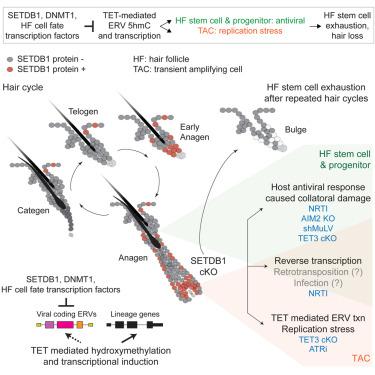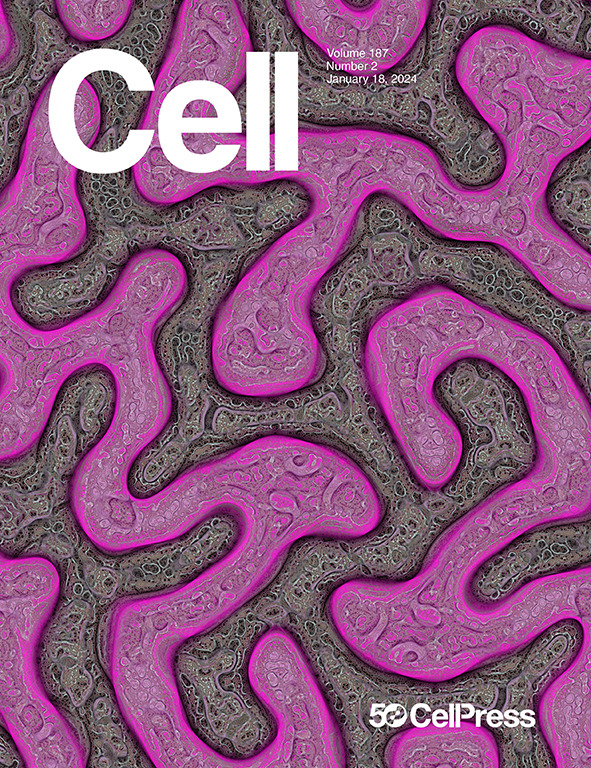Stem cell activity-coupled suppression of endogenous retrovirus governs adult tissue regeneration
IF 45.5
1区 生物学
Q1 BIOCHEMISTRY & MOLECULAR BIOLOGY
引用次数: 0
Abstract
Mammalian retrotransposons constitute 40% of the genome. During tissue regeneration, adult stem cells coordinately repress retrotransposons and activate lineage genes, but how this coordination is controlled is poorly understood. Here, we observed that dynamic expression of histone methyltransferase SETDB1 (a retrotransposon repressor) closely mirrors stem cell activities in murine skin. SETDB1 ablation leads to the reactivation of endogenous retroviruses (ERVs, a type of retrotransposon) and the assembly of viral-like particles, resulting in hair loss and stem cell exhaustion that is reversible by antiviral drugs. Mechanistically, at least two molecularly and spatially distinct pathways are responsible: antiviral defense mediated by hair follicle stem cells and progenitors and antiviral-independent response due to replication stress in transient amplifying cells. ERV reactivation is promoted by DNA demethylase ten-eleven translocation (TET)-mediated hydroxymethylation and recapitulated by ablating cell fate transcription factors. Together, we demonstrated ERV silencing is coupled with stem cell activity and essential for adult hair regeneration.

干细胞活动与内源性逆转录病毒的抑制共同作用于成人组织再生
哺乳动物反转座子占基因组的40%。在组织再生过程中,成体干细胞会协调地抑制逆转录转座子并激活系基因,但人们对这种协调是如何控制的还知之甚少。在这里,我们观察到组蛋白甲基转移酶SETDB1(逆转录转座子抑制因子)的动态表达密切反映了小鼠皮肤中干细胞的活动。SETDB1的消减会导致内源性逆转录病毒(ERV,逆转录转座子的一种)的重新激活和病毒样颗粒的组装,从而导致脱发和干细胞衰竭,而抗病毒药物是可逆的。从机理上讲,至少有两种在分子和空间上截然不同的途径起作用:毛囊干细胞和祖细胞介导的抗病毒防御,以及瞬时扩增细胞复制压力导致的抗病毒独立反应。DNA去甲基化酶十-十一易位(TET)介导的羟甲基化促进了ERV的再激活,而细胞命运转录因子的消减则再现了ERV的再激活。总之,我们证明了ERV沉默与干细胞活性有关,对成体毛发再生至关重要。
本文章由计算机程序翻译,如有差异,请以英文原文为准。
求助全文
约1分钟内获得全文
求助全文
来源期刊

Cell
生物-生化与分子生物学
CiteScore
110.00
自引率
0.80%
发文量
396
审稿时长
2 months
期刊介绍:
Cells is an international, peer-reviewed, open access journal that focuses on cell biology, molecular biology, and biophysics. It is affiliated with several societies, including the Spanish Society for Biochemistry and Molecular Biology (SEBBM), Nordic Autophagy Society (NAS), Spanish Society of Hematology and Hemotherapy (SEHH), and Society for Regenerative Medicine (Russian Federation) (RPO).
The journal publishes research findings of significant importance in various areas of experimental biology, such as cell biology, molecular biology, neuroscience, immunology, virology, microbiology, cancer, human genetics, systems biology, signaling, and disease mechanisms and therapeutics. The primary criterion for considering papers is whether the results contribute to significant conceptual advances or raise thought-provoking questions and hypotheses related to interesting and important biological inquiries.
In addition to primary research articles presented in four formats, Cells also features review and opinion articles in its "leading edge" section, discussing recent research advancements and topics of interest to its wide readership.
 求助内容:
求助内容: 应助结果提醒方式:
应助结果提醒方式:


